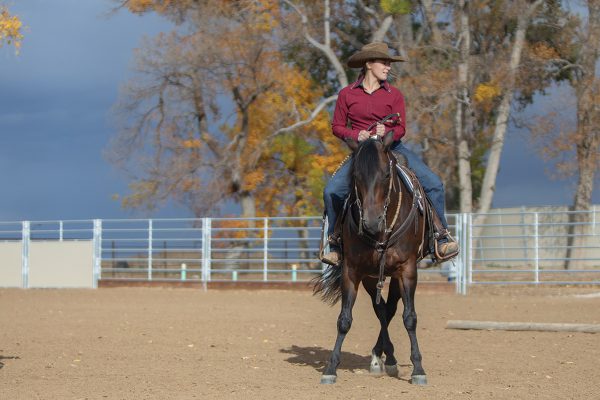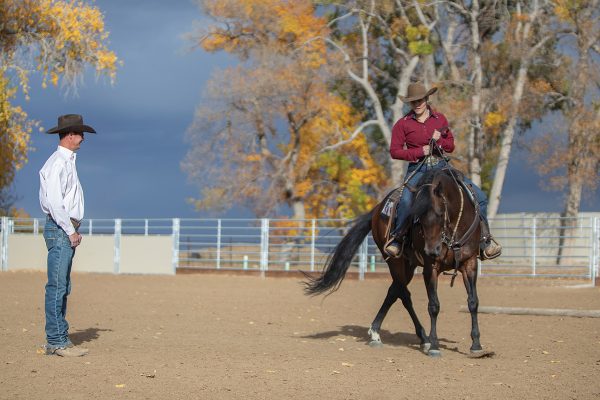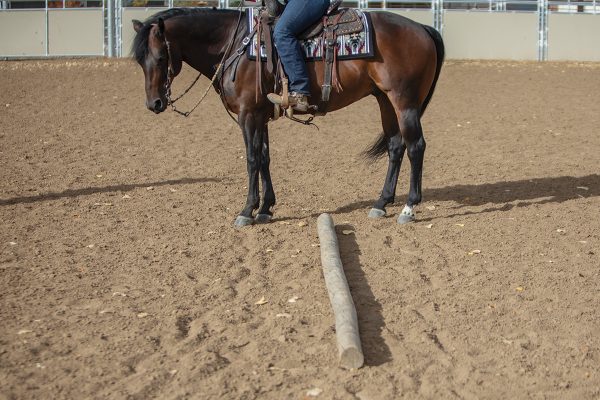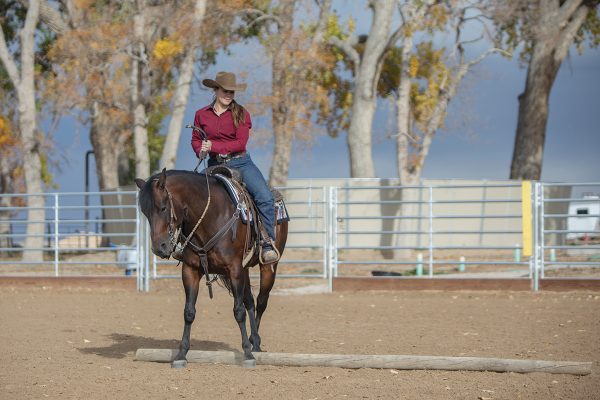
The sidepass is a common maneuver for ranch and trail classes. In the show ring, your horse should move carefully and willingly sideways across a pole at your command without knocking the pole. He must move directly to the side without taking a step forward or back—all while keeping the pole evenly spaced between his front and back hooves.
While it may make sense to find a pole and start practicing for this precise obstacle, trainer Cody Crow teaches his ranch riding students to work without the pole first. Once you can control your horse’s shoulders and hips while you’re away from the pole, your sidepass over the obstacle will be fluid and easy.
Here, Cody helps make sure you’re warmed up and in the correct position to sidepass easily. He’ll also provide tips to help you overcome common show pen mishaps.
Warm Up
Before you practice sidepassing, make sure your horse is warmed up. Lope some large circles and practice a few turnarounds. You’ll begin by working in the middle of the arena, away from any obstacles or poles.

“Move the horse’s hips and shoulders around,” Cody says. “If you can’t move your horse’s hips and shoulders independently, you won’t be able to move them simultaneously, as required in the sidepass. Start with a simple turn on the forehand so that you can isolate your horse’s front end and move his hips freely. You’ll also want to do a turn on the haunches, moving his front legs and keeping the hips stationary.”
Cody encourages his horses to move forward freely as well as doing slow lateral work. Ask your horse to walk or trot forward, then cue him to move to the side without turning his neck. In this “two track” move, you can move your inside leg close to your horse’s girth to stop him from bending into a turn while your outside leg moves slightly back and applies pressure.
“Do a two-track to move the horse laterally,” Cody says. “You want some forward motion but move the horse [sideways]. Only after I have some forward motion will I do some sidepassing away from the pole. Can I move the hip? Can I move the front end? Can I sidepass without the pole? If you haven’t gotten the horse warmed up and moving freely, adding the pole can make the horse feel claustrophobic and stuck. When I have all those parts checked off, then I’ll introduce the pole.”
Pole in Position
If your heel falls naturally straight from the hip, you’ll be able to cue well. If the pole is placed right behind the heel, that gives you the most room between the pole and the horse’s hooves.

“To initiate the sidepass, pick straight up on the reins first to block forward motion,” Cody says. “Going to the left, I’ll first move my reining hand straight up. Then I’ll place my left leg up by the front cinch and apply light pressure with my calf. My outside leg will be in the middle of the horse’s barrel or slightly (1 inch) back. I’ll push with that outside leg and cluck at the same time. The more clucking, the faster the tempo the horse should move.”
Cody says many horses will move first with their shoulder but leave their hip behind and to the outside. Rather than just pushing harder to get the hip to catch up, keep your inside leg up by the front cinch to slow the shoulder down. Move your outside leg back an inch or two to prompt the hip to catch up.
Sidepass Practice Tips
If your horse is just learning to sidepass, Cody suggests that you step the front legs over the pole, get in the right position, then sidepass off the pole. This will allow your horse to take just a few steps and be done. Your horse gets a reward for being calm. Only once he is comfortable with the pole between his legs should you start the sidepass from off the pole, onto it, and over the whole thing all in one movement.
Cody says many horses tend to rock back when sidepassing. If you can sidepass one or two steps and then allow the horse to move forward off the pole, it helps the horse associate the reward with moving forward.
Troubleshooting: If your horse steps back, walk forward and off the pole to help keep him calm and relaxed. If your horse hits the pole because he isn’t working off your leg easily, go back to sidepass off the pole. Don’t allow your horse to get stressed with the pole beneath his hooves.
Secrets for Sidepassing in the Show Pen
Cody says some horses anticipate the sidepass. In a show pattern, it’s common to trot up next to the pole, then stop and prepare to sidepass. If your horse starts to sidepass before you cue for it, he could step over before you’re lined up well.
To avoid this, trot up to the pole, then stand still in position for 30 seconds before sidepassing. The next time, trot up, stand, and move forward without doing the obstacle. Do the opposite of what your horse is anticipating.
Some horses rush over the pole. To correct this, sidepass a few steps, then stand and have the horse wait for another cue.

Other horses sidepass well over most of the pole, then drag their feet when they get to the end because they know they are almost done. For those horses, continue to sidepass even once you’ve reached the end of the pole.
“Make the horse realize that sidepassing doesn’t have to end just because the pole ends,” says Cody. “When you practice in open areas and mix up your training, your horse will listen to you instead of guessing what’s next.”
Special thanks to Payton Porterfield and her horse, Steps of Perfection, for demonstrating these exercises.
This article about how to sidepass a horse appeared in the March/April 2023 issue of Young Rider magazine. Click here to subscribe!


